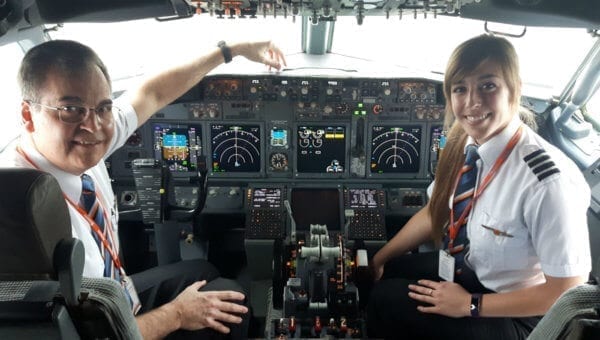It was foggy and unseasonably warm on Feb. 23 as a Sunwing Boeing 737-800 landed at the Region of Waterloo International Airport and taxied up to the terminal.

Inside the building, a large group of people was eagerly anticipating the plane’s arrival. On hand were representatives from the University of Waterloo (UW), Waterloo Wellington Flight Centre (WWFC), airport staff and members of the media–all there to celebrate four brand new Sunwing first officers who are among the first direct-entry cadets the leisure airline has ever hired.
As First Officer Chelsea Anne Edwards descended the airstairs to the wet tarmac, she was joined by three of her fellow graduates from the four-year aviation program offered by the UW and WWFC. Founded in 2007, the program–which leads to an Honours Bachelor of Environmental Studies in Geography and Aviation or to an Honours Bachelor of Science in Science and Aviation–has produced six graduating classes whose members are now flying around the world.
It’s safe to say, however, that the class of 2016 represents a major milestone for the program. It’s the first time its graduates have been offered direct-entry co-pilot positions with Sunwing Airlines. Edwards–together with Cameron Fuchs, Spencer Leckie and Siobhan O’Hanlon, all aged 23–found themselves going from graduation to the right seat of a 737 in just one year.
Two of the new first officers, Edwards and Fuchs, told Skies that the transition from WWFC aircraft to the right seat of a Boeing 737 was akin to drinking from the proverbial fire hose.
“It was busy, but we were well prepared from the Flight Centre and the training at Sunwing is first class. It all went well, but there were certainly challenges,” said Fuchs.
Edwards agreed. “It was the hardest thing I’ve ever done,” she said. “Still, when I get in the plane, I just can’t believe it. I never thought this would happen, never! I thought I’d be working in Yellowknife. It’s unreal. I love working here.”
To quote Bob Dylan, the times they are a-changing. No longer do aviation program grads face years of flight instructing or toiling in the Canadian bush before an airline will even consider them for a first officer position. In fact, Sunwing took on the four UW/WWFC graduates–plus two more from Seneca College–with most of them in the neighbourhood of 250 hours total flight time.
At the event on Feb. 23, the airline confirmed the program’s success and announced its plans to take on a new crop of cadets from both post-secondary programs beginning in July 2017.
“Attracting high calibre graduates to join our flight team is essential to our growth and success as an airline,” said Capt John Hudson, Sunwing’s manager of standards. “We were extremely pleased with the performance of the cadets that graduated from the program this summer, and hired four of them as first officers upon completion of their studies. We expect to hire similar numbers of graduates next year.”

Partnerships between academia and industry are becoming increasingly common in the Canadian flight training landscape.
An early model dates back to 2007, when Jazz Aviation debuted its Jazz Award program in collaboration with select aviation colleges and universities. Today, it has been rebranded as the Jazz Aviation Pathways Program (Jazz APP) and expanded to include eight schools and three industry partners from across the country.
Meanwhile, the Jazz Cadet program continues with Seneca College. It now includes a new instructor pathway program, which will give past Seneca grads–who subsequently took instructing jobs with the college–the chance to land a pilot position with the airline.
Air Georgian has also offered a mentorship program to Seneca students since 2008. “Seneca will forward us resumes of graduates that stood out, who they strongly recommend,” said Dan Bockner, VP of operations and security at Air Georgian. “We want to take the highest performers from the program and bring them onto the Beech 1900 as first officers with as little as 250 hours of flying time.”
He said Air Georgian has hired a total of about 25 Seneca grads since the beginning of the mentorship program.
“When they come in, they get the same training anyone else does. There are some limitations. The low-time pilots do get 50 per cent more line indoc–60 hours versus 40 hours for a normal hire,” said Bockner. “We’re so comfortable with it that we’re really good at doing it now, and doing it safely and mitigating any risks. Since they perform so well, there really aren’t a lot of risks.”
Lynne McMullen, director of business development at Seneca’s School of Aviation, told Skies that these partnerships are a sign of things to come.
“Ultimately, what will happen is greater collaboration through the industry,” she said. “Schools are moving to partner with industry to move students along on a defined career path and they will choose the program with the pathway option that’s right for them, depending on their ultimate goal.”